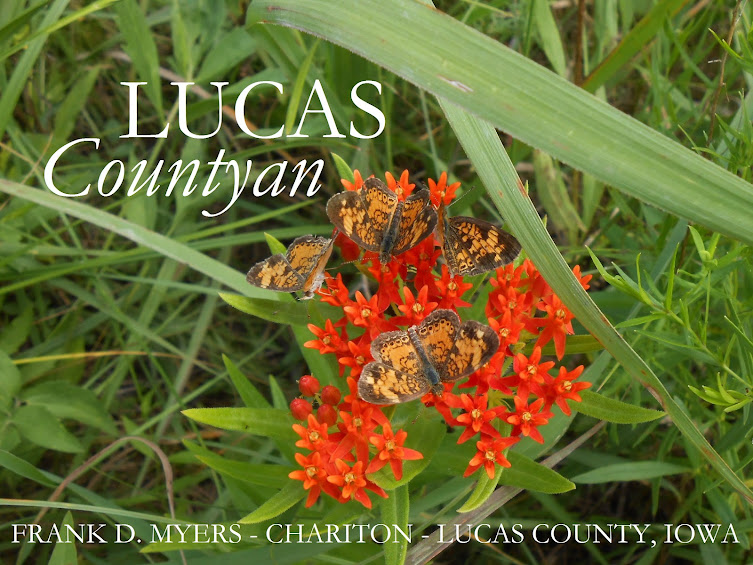Yesterday's pre-graduation reception for my neighbor, the accomplished Ms. Madelyn, served to remind that commencement exercises for the Chariton High School Class of 2021 are just a week away --- scheduled for 3 p.m. next Sunday in the high school gymnasium. Graduation was disrupted last year by COVID-19, but will proceed this year --- masks are mandatory, however. There will be 69 graduates.
Looking back 120 years --- to the 27 CHS graduates who called themselves the "Twentieth Century Class" --- the contrasts are notable. Chariton was about the same size with a population of 4,000 (today, it's about 4,250), but class size was considerably smaller. A high school education still was not considered necessary by many; a number of small private schools were in operation, too. And only five of the 27 graduates were young men.
Graduation itself was a two-evening affair --- each graduate was expected to speak during the exercises and that required time. The program, as published in The Democrat of May 16, is at the top here. The site was the second-floor assembly hall of the brand new high school building, later named Alma Clay in honor of a beloved teacher, which had just opened its doors in the spring.
The congregation of First Baptist Church had taken on the responsibility the previous Sunday of organizing a baccalaureate service in conjunction with its regular morning service. A majority of class members attended and heard an encouraging sermon by the Rev. Wilson Mills.
The Chariton Herald, in its edition of May 16, also offered readers an introduction to the 27 graduates, as follows:
+++
The Chariton high school has twice graduated larger classes than the one this year will be, there having been 38 members in the class of 1897 and 33 in the class of 1898. This year's class consists of 27 members and has named itself the "Twentieth Century Class." It takes the prize for good looks, if not for numbers. The members will each deliver a graduation oration at exercises to be held in the high school hall on next Thursday and Friday evenings. Following is the personnel of the class:
Ethel Whitten was born in Lexington, Nebraska, April 9, 1884. She entered the Chariton schools at the age of nine years and reached the high school in 1897.
Lilly Belle Redlingshafer was born on a farm about seven miles southeast of Chariton in 1882. She started to the Myers school, about a mile from her home, at the age of seven. She attended there until she graduated in 1898 and in the fall of this year entered the Chariton high school.
Katharine Vollmar was born in Mt. Ayr, Ia., Nov. 11, 1885. Her's has been the real life of an itinerant's daughter. She has attended school at Stuart, Ia., going her first day at that place. She also attended at Girard, Garnett and Paola, Kansas, finishing the grammar grade at the last named place. In 1897 she attended school at Corydon and the following year her father was appointed pastor of the M.E. church of this city and she finishes her common school course in Chariton.
Maude Boylan was born in Chariton on August 31, 1884. All of her education has been received at the school buildings of our city under an able corps of teachers.
John Milton Burr Reed was born three and one-half miles south of Chariton, Dec. 2, 1883. Commenced to attend school here at the age of six, always attending here.
Nettie M. Spencer was born in Chariton, November 15, 1882. Her parents have always lived here, and she has been a regular attendant at the schools in this city since she reached the age of seven years; entering the high school in 1897.
Lizzie Dorsey was born in Chariton in 1883 and started school at the age of five years. Entered the high school in 1897.
Agnes Mae Bellor was born in this city Jan. 19, 1883. at the age of five, she entered school at the old Bancroft building, was transferred to the Columbus building. Entered the high school in 1897.
Freda A. Larson was born in Chariton, April 20, 1882. Started to school at the age of seven at the Columbus building and later was transferred to the Franklin building. Entered the high school in 1897.
Rena Criswell was born in Afton, July 27, 1883. Entered the primary grade of Villisca school and remained there until the spring of 1898 when she entered the Chariton high school and will finish the Latin course.
Ethel Grace Evans was born in Washington township, Sept. 25, 1881. Started to school in the home district at the age of six. Also attended school at Delphos, Afton and Red Oak. In the spring of 1992, she returned to the old home in this county and completed the common school course in 1897, entering the Chariton high school in the fall of 1898.
John Martin Law was born in Chariton, November 7, 1882. At the age of five he started to school at the old Bancroft building and has received transfers to five different school buildings, entering the high school in 1897.
Agnes Wilson was born in Rock Island, Ill., March 29, 1883. She entered the primary grade of Chariton school. At the age of nine she went to Mt. Ayr and attended school there for four years. She then returned to Chariton, entering the high school in 1897.
Mary Elizabeth Carpenter was born on a farm seven miles southeast of Chariton Dec. 12, 1883. Received her early education in the country schools and entered the Chariton high school in 1898.
John Leo Carpenter was born seven miles south of Chariton Jan. 13, 1885. At the age of five he commenced school at the Braden school, entered the Chariton high school in 1898.
Dorothy Carroll was born at Lucas Oct. 28, 1884. Entered Lucas school at age of five, moved to Melrose at age of eight and to Chariton in 1890. Attended school at the Franklin building until she entered the high school in 1897.
Jessie Crowley was born in Chariton November 15, 1883. She has received all of her education in the proficient schools of Chariton.
Grace Richmond, the only colored student in the class, was born in Landcastle, Wis., June 29, 1882. She came to Chariton when quite young and has been a zealous student in the Chariton schools.
Gussie Leinen was born in Chariton Oct. 20, 1884. Entered school at the Columbus school and entered the high school in 1898. She attended German school one year in Burlington during this time.
Blanch Willoughby was born in Chariton July 30, 1883, and has received her education in the Chariton public schools.
Theo Bentley was born in Chariton Dec. 24, 1884. She started to school here but only attended a few months, when she went to Atlanta, Ga. she returned to Chariton in 1892 and has attended school here since that time.
Arlie Curtis was born in Chariton in 1883. He has at different times attended every school building in the city, entering the high school in 1897.
Carrie Edna Beswick was born in Whiteside county, Ill., August 15, 1882, and attended school there until 1898, when she came to Chariton, making her home with her aunt, Mrs. T.H. Milnes, and attending the Chariton high school.
Amanda Louisa Westling was born in Chariton April 13, 1884. At the age of five she commenced school at the Columbus building, but soon afterward was transferred to the Franklin building, entering the high school in 1897. She also attended the Swedish summer school for seven terms.
Clara Jane Rose was born in Templeton on June 12, 1884. When she was five years old, she first started to school in Canada while there on a visit. Upon returning to Chariton she attended school but later went to the Freedom school, south of the city. She entered in the high school in 1898.
Howard Melville Rose was born at Carroll, Dec. 7, 1885. When four years old he started school at the Columbus building in Chariton, but soon moved with his parents seven miles south of the city and attended the Freedom school. He returned to Chariton in 1898 and entered the high school.
Josephine Middleton was born in Fairbury, Nebr., in 1882. The first years of her school life were spent in Blue Springs, Nebr. Later she attended school in Ottumwa. In 1895 she went to Oskaloosa and attended school there until last year when she came to Chariton with her parents and entered the "Twentieth Century Class."







































